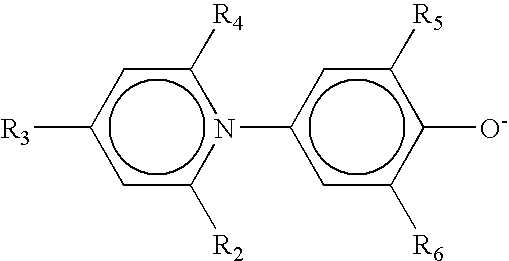Liquid sample assay device
- Summary
- Abstract
- Description
- Claims
- Application Information
AI Technical Summary
Problems solved by technology
Method used
Image
Examples
example 2.0
[0049] As well as bromocresol green, other pH indicators may readily be substituted by one skilled in the art. Both acid and alkaline forms of indicators may be used. For example, malachite green hydrochloride can be immobilised in pH 14 buffer and undergoes a clear to blue colour transition when urine is added. Phloxine B is immobilised below pH 2.2, where it is initially colourless and then changes colour to pink when urine is added. In selecting an alternative indicator, a number of parameters must be considered:
[0050] (i) The pKa / b of the indicator. This should preferably be in the range 0-5 or 8-14, more preferably in the range 2-4.75 or 8.5-10
[0051] (ii) The colour change should be unambiguous, changing to a strong, bright colour. Desirably, it may be from white or clear to blue. Ideally it will avoid colours such as yellow, brown and red that are not perceived as pleasant.
[0052] (iii) The indicator should not interfere with the functioning of the assay or the wick.
[0053] (iv)...
example 2.1
[0056] This example relates to a general method for preparing a bicomponent bibulous wick member for use in an assay device in accordance with the invention.
[0057] 1. A bicomponent wick is prepared having a core of polyester surrounded by a sheath of Nylon. The Nylon sheath is optionally treated with a surface active agent (such as Tween 20 or Triton X-100 or the like) to optimise its ability to be wetted by aqueous solutions. The wicks are then immersed in a dilute solution (0.05 gms l.sup.-1) of phloxine B in deionised water. The water swells the sheath and the dye ingresses into the fibres with the water and, without being bound by any particular theory, the inventors hypothesise that hydrogen bonding may be responsible for retention of the dye by the fibre.
[0058] 2. After 5 minutes' immersion the wicks are withdrawn from the phloxine B solution and immediately washed in deionised water until the wash liquor shows no sign of any dissolved dye. The wicks are stained pink in colour...
example 2.2
[0062] Instead of a single pH indicator, it may be desired to use a dye in combination with an indicator or to use two or more dyes in conjunction. A mixture of an indicator and a dye is known as a "screened indicator". For example, methyl orange (a colour changing indicator) and xylene cylanol (a blue dye), when mixed and immobilised in poly(HEMA) as before, give a screened indicator system which, in moving from acidic to basic conditions, changes from green to magenta. A suitable indicator can be formed from 0.14 g of xylene cyanol FF (Aldrich) and 0.1 g of methyl orange in 100 ml distilled water. This solution is magenta when acidified to pH 2 and green when taken to pH 6. This is because methyl orange is red in acid (pH3.2) and is yellow in base (pH4.4) and the xylene cyanol FF is blue independent of pH.
PUM
 Login to View More
Login to View More Abstract
Description
Claims
Application Information
 Login to View More
Login to View More - R&D
- Intellectual Property
- Life Sciences
- Materials
- Tech Scout
- Unparalleled Data Quality
- Higher Quality Content
- 60% Fewer Hallucinations
Browse by: Latest US Patents, China's latest patents, Technical Efficacy Thesaurus, Application Domain, Technology Topic, Popular Technical Reports.
© 2025 PatSnap. All rights reserved.Legal|Privacy policy|Modern Slavery Act Transparency Statement|Sitemap|About US| Contact US: help@patsnap.com



